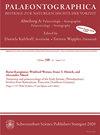Two new neoselachian sharks (Elasmobranchii, Neoselachii, Synechodontiformes) from the Rhaetian (Late Triassic) of Europe
IF 1.8
2区 地球科学
Q2 PALEONTOLOGY
Palaeontographica Abteilung A-Palaozoologie-Stratigraphie
Pub Date : 2014-12-23
DOI:10.1127/PALA/303/2014/137
引用次数: 11
Abstract
Two new Late Triassic shark species (Synechodus seinstedtensis sp. nov., Parascylloides turnerae gen. nov. sp. nov.) belonging to the extinct order Synechodontiformes Duffin & Ward, 1993 (Chondrichthyes, Elasmobranchii, Neoselachii) are described on isolated oral teeth from Rhaetic deposits of North Germany and England.The term “polyhemiaulacorhize” is introduced for the synechodontiform type of root architecture in order to replace the misleading term “pseudopolyaulacorhize”. The teeth of Parascylloides turnerae gen. nov. sp. nov. were identified previously as symphyseals or parasymphyseals of Rhomphaiodon minor (Agassiz, 1837). They are considered here as belonging to a different, new species because of their frequency and their morphological differences to other Triassic neoselachian teeth. The teeth of both new species show a triple-layered enameloid microstructure consisting of an external shiny-layered enameloid (SLE), a middle parallel-bundled enameloid (PBE) and an internal tangled-bundled enameloid (TBE). In Synechodus seinstedtensis sp. nov. the PBE contains probably radial bundles of apatite cristallites whereas these are lacking in the PBE of Parascylloides turnerae gen. nov. sp. nov.. The systematical significance of the presence or absence of radial bundles in the PBE remains unclear. Zusammenfassung Anhand von Zähnen aus obertriaszeitlichen Rhät-Ablagerungen von Norddeutschland und England werden zwei neue Haiarten (Synechodus seinstedtensis sp. nov., Parascylloides turnerae gen. nov. sp. nov.) aus der ausgestorbenen Ordnung Synechodontiformes Duffin&Ward, 1993 (Chondrichthyes, Elasmobranchii, Neoselachii) beschrieben. Für die Charakterisierung derWurzelmorphologie synechodontiformer Zähne wird der Begriff „polyhemiaulacorhiz“ an Stelle des irreführenden älteren Terminus „pseudopolyaulacorhiz“ eingeführt. Die Zähne von Parascylloides turnerae gen. nov. sp. nov. wurden zuvor als Symphysenoder Parasymphysenzähne von Rhomphaiodon minor (Agassiz, 1837) angesprochen, werden hier jedoch aufgrund ihrer Häufigkeit und morphologischen Eigenart einer neuen Haiart zugeordnet. Der Zahnschmelz ist in beiden neuen Arten dreilagig aufgebaut und besteht aus einer äußeren Glanzschicht (SLE), einemmittleren parallelfaserigen Schmelz (PBE) und einem inneren wirrfaserigen Schmelz (TBE). Der parallelfaserige Schmelz zeigt in beiden Arten vertikale, oberflächenparallele Fasern aus Apatit-Kristalliten. Während im PBE von Synechodus seinstedtensis sp. nov. wahrscheinlich auch radiale Faserzüge vorhanden sind, fehlen diese im PBE von Parascylloides turnerae gen. nov. sp. nov. Die systematische Bedeutung des Vorhandenseins oder Fehlens von radialen Faserzügen im PBE, ein Phänomen, das auch bei anderen triassischen Neoselachiern beobachtet werden kann, bleibt unklar.两条新塞拉目鲨鱼(Elasmobranchii, Neoselachii, synnechodontiformes),来自欧洲雷提亚(晚三叠世)
两个新的晚三叠世鲨鱼物种(Synechodus seinstedtensis sp. nov., Parascylloides turnerae gen. nov.)属于已灭绝的Synechodontiformes Duffin & Ward, 1993 (Chondrichthyes, Elasmobranchii, Neoselachii)在德国北部和英格兰Rhaetic沉积物的分离口腔牙齿上被描述。为了取代“伪多牙根”这一误导性的术语,“多牙根”一词被引入到共齿状根结构类型中。Parascylloides turnerae gen. nov. sp. nov.的牙齿以前被鉴定为Rhomphaiodon minor的联合或副联合(Agassiz, 1837)。它们被认为属于一个不同的新物种,因为它们的频率和形态与其他三叠纪新塞拉奇齿不同。这两个新物种的牙齿均呈三层状的类牙釉质微观结构,包括外部亮层类牙釉质(SLE)、中间平行束状类牙釉质(PBE)和内部缠结束状类牙釉质(TBE)。在Synechodus seinstedtensis sp. 11 .的PBE中可能含有放射状的磷灰石晶体束,而在Parascylloides turnerae gen. 11 . sp. 11 . 11 .中则缺乏。放射状束在PBE中存在或不存在的系统意义尚不清楚。zusmenfassung Anhand Zähnen aus obertriaszeitlichen Rhät-Ablagerungen von Norddeutschland and England werden zwei neue haarten (Synechodus seinstedtensis sp. 11, parascylides turnerae gen. 11 . sp. 11 .) aus der ausgestorbenen Ordnung Synechodontiformes Duffin&Ward, 1993 (chondrichthes, Elasmobranchii, Neoselachii) beschrieben。 die Charakterisierung derWurzelmorphologie synnechodontiformer Zähne wird der Begriff“polyhemaulacorhiz”和Stelle des irrefhrenden älteren Terminus“pseudpolyaulacorhiz”eingef hrt。Die Zähne von Parascylloides turnerae gen. nov. sp. nov. wurden zuvor als Symphysenoder Parasymphysenzähne von Rhomphaiodon minor (Agassiz, 1837) angesprochen, werden hier jedoch aufgrund irer Häufigkeit and morphologischen Eigenart einer neuen haart zugeordnet。Der Zahnschmelz ist in been neuen Arten dreilagig aufgebaut and bestebest aus einer äußeren Glanzschicht (SLE), einemmitleren parallelfaserigen Schmelz (PBE)和einem innerirfaserigen Schmelz (TBE)。Der parallelfaserige Schmelz height in en Arten vertikale, oberflächenparallele Fasern aus Apatit-Kristalliten。Während im PBE von synnechodus seinstedtensis sp. 11 . wahrscheinlich auch radiale faserz ge vorhanden sind, fehlen diese im PBE von parascyloides turnerae gen. 11 . sp. 11 . Die systematische Bedeutung des Vorhandenseins oder Fehlens von radialen faserz gen im PBE, ein Phänomen, das auch bei anderen triassischen neselachiern bebacachtet werden kann, bleibt unklar。
本文章由计算机程序翻译,如有差异,请以英文原文为准。
求助全文
约1分钟内获得全文
求助全文
来源期刊
CiteScore
3.80
自引率
3.70%
发文量
21
审稿时长
>12 weeks
期刊介绍:
Palaeontographica Section A publishes peer reviewed results of studies on palaeozoology, paleoecology and biostratigraphy. Its large paper format provides sufficient space for large tables, illustrations, photographs and Palaeontographica’s renowned plates.
Published contributions span all areas of palaeozoology, i.e., systematic, phylogenetic and ecological aspects. Careful peer review ensures the high quality of the papers, covering localities all over the world. Many landmark papers in palaeozoology and biostratigraphy were published in Section A of Palaeontographica. This includes numerous lavishly illustrated monographs of certain groups of fossils and stratigraphic ranges. These monographs, are typical for Paleontographica papers, characterised by numerous highest quality plates and are printed on special high quality paper for excellent reproduction of picture plates.

 求助内容:
求助内容: 应助结果提醒方式:
应助结果提醒方式:


